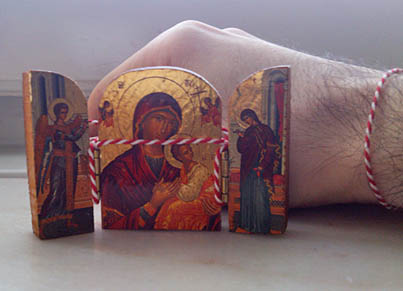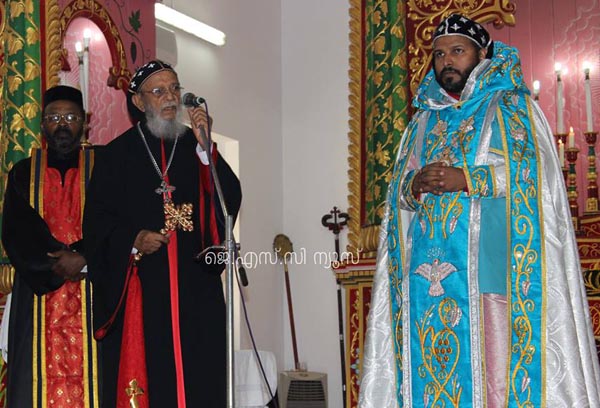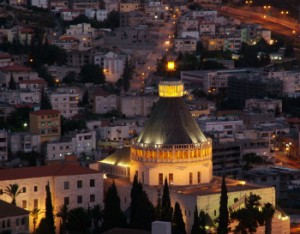
|
||
|
Malankara World Journal
Special: Annunciation to St. Mary
Volume 5 No. 271 March 24, 2015
If the Journal is not displayed properly, please click on the link below (or copy and paste) to read from web
http://www.MalankaraWorld.com/Newsletter/MWJ_271.htm Archives: http://www.MalankaraWorld.com/Newsletter/Default.htm |
||
|
||
|
TABLE OF CONTENTS
|
||
|
If you are not receiving your own copy of
Malankara World by email, please add your name to our subscription list. It
is free. click here.
|
||
|
1. Bible Readings for The Annunciation to St. Mary (March 25) Bible Readings For The Annunciation to St. Mary 2. Sermons for The Annunciation to St. Mary (March 25)
3. Malankara World Supplement on St. Mary Features 4. Syriac Orthodox Church Virgin Mary Annunciation Tradition - The 'Siboro'
5. Annunciation
6. Nazareth: I am the Servant of The Lord "I am the Lord's servant," Mary answered. "May it be to me as you have said." Then the angel left her.Without exaggeration we could call this one of the greatest statements of faith in all the Bible. We read it so often we forget how great it really is. Without warning she meets Gabriel who announces that she will become pregnant by the Holy Spirit and give birth to the Son of God. When she asks how, he says, "Don't worry about it. The Holy Spirit will cover you like a cloud and you'll end up pregnant. That's all there is to it." What do you say to that? ... 7. The Unsearchable Mysteries of God
10. First Dukhrono of LL Moran Mor Ignatius Zakka 1 Iwas
|
||
|
Malankara World Supplement on St. Mary |
||
|
For more articles, hymns, prayers, and eBooks on St. Mary, please visit
Malankara World Supplement on St. Mary
here: http://www.MalankaraWorld.com/Library/shunoyo/StMary.htm Malankara World Journal Specials on Annunciation to St. Mary:
Volume 4 No 247: November 21, 2014
Volume 3 No 132: Mar 21 2013
Volume 2 No 111: Nov 29 2012
Volume 2 No 110: Nov 22 2012 |
||
|
Features
|
||
|
The Syriac Orthodox Church (Suryoye) celebrate the Annunciation of the Virgin
Mary on March 25th. The church has a tradition that may be unique to Suryoye - the faithful put on a so called "Siboro" around their wrist. This "Siboro"
consists of a white thread and a red thread wound together.
 The "Siboro" is worn from March 25th (the day of the Annunciation to the Virgin
Mary) until Easter Day when it is clipped off and burnt.
The "Siboro" is worn from March 25th (the day of the Annunciation to the Virgin
Mary) until Easter Day when it is clipped off and burnt.
 Editor's Note:
Romanians and Bulgarians have a similar folk custom. It's not connected to the
Feast of Annunciation, though. Mărțișor, marț and mărțiguș are all names for the
red and white string from which a small decoration is tied, and which is offered
by people on the 1st day of March. Giving this talisman to people is an old
custom, and it is believed that the one who wears the red and white string will
be strong and healthy for the year to come. It is also a symbol of the coming
spring. Usually, both women and men wear it pinned to their clothes, close to
the heart, until the last day of March, when they tie it to the branches of a
fruit-tree.
The Armenians have something similar called "narod," which is used during
baptisms and weddings.
Siboro's connection to Annunciation is unique to The Syriac Orthodox Church (Suryoye).
Editor's Note:
Romanians and Bulgarians have a similar folk custom. It's not connected to the
Feast of Annunciation, though. Mărțișor, marț and mărțiguș are all names for the
red and white string from which a small decoration is tied, and which is offered
by people on the 1st day of March. Giving this talisman to people is an old
custom, and it is believed that the one who wears the red and white string will
be strong and healthy for the year to come. It is also a symbol of the coming
spring. Usually, both women and men wear it pinned to their clothes, close to
the heart, until the last day of March, when they tie it to the branches of a
fruit-tree.
The Armenians have something similar called "narod," which is used during
baptisms and weddings.
Siboro's connection to Annunciation is unique to The Syriac Orthodox Church (Suryoye).
|
||
|
by His Eminence Archbishop Mor Clemis Eugene Kaplan |
||
|
By Dr. Ray Pritchard "In the sixth month, God sent the angel Gabriel to Nazareth, a town in Galilee, to a virgin pledged to be married to a man named Joseph, a descendant of David. The virgin's name was Mary" (Luke 1:26-27).These two verses set the historical framework for the birth of Jesus. They tell us that this episode is not the figment of some writer's imagination. In the history of the church Mary has often been portrayed as a kind of misty, other-worldly figure. If you look at some of the great paintings of Mary, they make her look so peaceful and beatific you almost forget she was a real person. That's a shame because Luke makes it clear that she was very real, with very real doubts, very real questions, and very real faith. Nowhere is this seen with more clarity than in verse 38: "I am the Lord's servant," Mary answered. "May it be to me as you have said." Then the angel left her.Without exaggeration we could call this one of the greatest statements of faith in all the Bible. We read it so often we forget how great it really is. Without warning she meets Gabriel who announces that she will become pregnant by the Holy Spirit and give birth to the Son of God. When she asks how, he says, "Don't worry about it. The Holy Spirit will cover you like a cloud and you'll end up pregnant. That's all there is to it." What do you say to that? Mary said yes. Yes to God, Yes to the impossible, yes to the plan of God. When the angel said, "Nothing is impossible with God" (v. 37), Mary took a deep breath and replied, "May it be to me as you have said" (v. 38). And so the great journey began. Grant us faith, O Lord, to believe all that you have spoken, even that which seems impossible to us. Amen. Source: Keep Believing Ministries |
||
|
From a Homily by St Ambrose, Bishop & Doctor The Lesson from the Holy Gospel according to Luke. (Luke 1:26-38) At that time: God sent the angel Gabriel to a city of Galilee called Nazareth, where a Virgin dwelt, betrothed to a man of David's lineage; his name was Joseph, and the Virgin's name was Mary. ... The mysteries of God are unsearchable, and it is especially declared by a Prophet, that a man can hardly know his counsels. Nevertheless, some things have been revealed to us, and we may gather from some of the words and works of the Lord our Saviour, that there was a special purpose of God, in the fact that she who was chosen to be the Mother of the Lord was espoused to a man. Why did not the power of the Highest overshadow her before she was so espoused? Perhaps it was lest any might blasphemously say that she had conceived in adultery the Holy One. "And the Angel came in unto her." Let us learn from this Virgin how to bear ourselves, let us learn her modesty, let us learn by her devout utterance, above all let us learn by the holy mystery enacted. It is the part of a maiden to be timid, to avoid the advances of men, and to shrink from men's addresses. Would that our women would learn from the example of modesty here set before us! She upon whom the stare of men had never been fixed was alone in her chamber, and she found herself alone with Angels. There was neither companion nor witness there, that what passed might not be debased in gossip: and the Angel saluted her. The message of God to the Virgin was a mystery, which it was not lawful for the mouth of men, but only of Angels, to utter. For the first time on earth the words are spoken: "The Holy Ghost shall come upon thee." The holy maiden hears, and believes. At length she said: "Behold the handmaid of the Lord: be it unto me according to thy word." Here is an example of lowliness, here is a pattern of true devotion. At the very moment that she is told she is chosen to be the mother of the Lord she at once declares herself his handmaid. The knowledge that she was Mother of God caused in the heart of Mary only an act of humility. Source: Vultus Christi |
||
|
by Patty Wudel We are quite a distance from the scripture readings for Advent and Christmas. In today's scripture reading, Jesus is already a grown man! Filled with the power of the Spirit, he has come through 40 days of temptation in the desert and he has begun to teach in the synagogues. Jesus visits his home synagogue and reads from Isaiah, "The Spirit of the Lord is upon me, because he anointed me to bring good news to the poor. He has sent me to proclaim release to the captives and recovery of sight to the blind, to let the oppressed go free, to proclaim the year of the Lord's favor." Jesus is, as Becca Stelle put it in her teaching several weeks ago, "going public" as a true revolutionary. This morning though, I invite you to step back with me to an earlier part of the liturgical calendar, a part that never really caught my attention until this year. But this year, I have been thinking quite a lot about the story of the Annunciation to Zechariah and to Mary by the angel Gabriel. I have been pondering the mystery of Annunciation and Incarnation because of several sweet connections that have come to me at Joseph's House. One connection is the friendship I have with a woman whose name is AG. AG is a resident at Joseph's House. She and I sometimes pray together in her room after dinner, before she goes to sleep. When we pray, AG asks me to light a candle and pray out loud to Mary for her. There was a time long ago when I, a Protestant raised woman, would not have been able to collect my thoughts and feelings and find the words to pray to Mary – but that was then. Now, because of AG I pray to Mary. And I find myself thinking about Mary at other times. AG invited me to go with her to the National Shrine of the Immaculate Conception – "I want to take you to Mary's house", she told me. Inside the shrine are many small chapels, each one dedicated to a different aspect of Mary. From the chapel of Our Lady of Perpetual Help to the chapel of Our Lady of Sorrows, AG hurried as though hurrying to meet a friend. There, in each chapel, she stopped and caressed the hands and feet of the statue of Mary. She murmured her love to her. She thanked her and blessed her. AG's prayers to Mary are specific – she prays for healing from her cancer and for an apartment of her own. Thus far AG has not received the answer to her prayers that she is asking for. But AG continues to pray and to receive blessings from Mary. To her, Mary is the blessed mother, Mary is her sister; Mary is her friend. Mary has never hurt her or disappointed her. I am moved, knowing this. My other connection to the Annunciation is through a particular essay in a book of readings for Advent and Christmas. Joel Zimmerman is a Bruderhoff friend who helps out at Joseph's House on Friday mornings. Joel brought us a copy of 'Watch for the Light'. Some of you may have it. Every day there is a different essay by someone who has reflected deeply on the Advent and Christmas scripture readings. The reading for November 30th is by Kathleen Norris, a poet and a convert to Catholicism. In this essay she reflects on the Annunciation by the angel Gabriel, and reading her essay, I was deeply attracted to that story for the first time. "Annunciation" means "the announcement". It is part of a language of story, poetry, image and symbol that for centuries our Christian tradition has used to convey the central tenets of our faith. It can be a kind of scary word, isn't it? The Annunciation story is a sort of scary story. It's a story about Mystery. I'm surprised, actually, that I am here this morning wanting to share with you my attraction to this Mystery story. More often I am moved by the social message of the Gospels. Kathleen Norris tells the story of a woman pastor who addresses an ecumenical assembly. "We all know there was no virgin birth", the pastor said. "Mary was an unwed, pregnant teenager and God told her it was okay. That's the message we need to give girls today, that God loves them, and to forget all this nonsense about a virgin birth". In contrast to the pastor there was a Benedictine, an Assiniboine Indian, who preached on the Annunciation to a First Nations congregation. "The first thing Gabriel does when he encounters Mary", the Assiniboine priest said, "is to give her a new name: 'Most favored one'. It's a naming ceremony", he emphasized, making a connection that excited and delighted his listeners."When I brood on the story of the Annunciation", Norris writes, "I like to think about what it means to be 'overshadowed' by the Holy Spirit. I wonder if a kind of overshadowing isn't what every young woman pregnant for the first time might feel, caught up in something so much larger than herself."There is the wonder of the pregnant mill-town girl in James Wright's poem, "Trouble". The butt of jokes, the taunt of gossips, she is amazed to carry such power within herself. "Sixteen years and all that time, she thought she was nothing but skin and bones". Leering across Pearl StreetCrum Andersen yipped Hey Pugh! I see your sister been rid bareback. She swallow a watermelon? Fred Gordon! Fred Gordon! Fred Gordon!Wayya mean? She can get fat, can't she? Fat? Willow and lonesome Roberta, running Alone down Pearl Street in the rain last time I ever saw her, smiling a smile Crum Anderson will never know, Wondering at her body.Sixteen years, and All that time she thought she was nothing But skin and bones. Wright's poem seems to do what the pastor talked about doing - it expresses God's love for a girl who finds herself - we used to say, "in trouble", but without the shallow assurance that "it's okay". Told all her life that she is "nothing", the girl discovers in herself another, deeper reality: A Mystery; something holy, with a potential for salvation. What would such a radically new sense of oneself entail? Could it be a form of virgin birth? Perhaps Mary's "yes" to her new identity, to the immense and wondrous possibilities of her new and holy name, can provide a means of conveying to girls, to young men - to fully grown women and fully grown men - that there is something in them that no one can touch: that belongs only to them, and to God.In the presence of Mystery, of a radically new sense of self, the remarks of the pastor at the conference reveal a narrow and impoverished concept of what virginity and virgin birth is. It's in the monastic world that one finds a broader and more relevant grasp of what it could mean to be virgin. Thomas Merton describes the true identity that he sought in contemplative prayer as a "point vierge" at the center of his being, "a point untouched by illusion, a point of pure truth…which belongs entirely to God, which is inaccessible to the fantasies of our own mind or the brutalities of our own will. This little point…of absolute poverty," he wrote, "is the pure glory of God in us."It matters for us to hear the message that God loves us, and the mystery of the Annunciation reveals an aspect of that love. It also suggests that our response to this love is critical. A few verses before the Angel appears to Mary in the first chapter of Luke, another annunciation occurs. The Angel announces to an old man, Zechariah, that his equally aged wife is to bear a son who will "make ready a people prepared for the Lord." The couple are to name him John. He is known to us as John the Baptist. Zechariah replies to the Angel, "How will I know that this is so?" Such a completely understandable response! Maybe he was afraid to refresh his dream of having a son in case he would be disappointed - devastated - yet again. Maybe he knew and didn't trust himself - after all, the Angel did not say that Elizabeth's pregnancy would happen by immaculate conception. How could he not ask of the Angel, "How can I be sure of this? How will I know that this is so?" given that he was old and his wife was past menopause? Yet, Zechariah's was a very different response from the one Mary makes. Mary replies to the Angel, "How can this be?" How can this be? For Kathleen Norris, Zechariah's response seeks knowledge and information from God. In her response to the Angel, Mary is receptive to wisdom; she is pondering a state of being. God's response to Zechariah is to make him speechless during the entire term of his wife's pregnancy. He doesn't speak again until after the child is born, and he has written on a tablet "His name is John". Perhaps Zechariah's punishment was actually a form of grace in that for nine months he could quietly think about his initial response when confronted with Mystery. When he does speak again, it is to praise God. He's had nine months to think it over!Mary's "How can this be?" is a simpler response than Zechariah's and also more profound. She does not lose her voice, but finds it. Like any of the prophets, she asserts herself before God saying, "Here am I." There is no arrogance, however, but only holy fear and wonder. Mary proceeds – as we must do in life – making her commitment without knowing much about what it will entail or where it will lead. Like the writer Kathleen Norris, I am compelled by the story of the Annunciation because of the questions about myself that it raises:
Aren't there annunciationsWould it be true to say that the questions God asks us are always questions of being, rather than of knowing? And that simply recognizing those moments of announcing - stopping for a moment because something or someone wants our attention - can matter. Chances are, we will not see or hear an angel. But it will be clear that we are being asked to say either "yes" or "no"; to embrace or ignore what God has set before us… Let us Pray Mary, Mother of compassion, you yourself know that the gift of God's Spirit within the flesh carries costly, necessary responsibilities. Your brave responsiveness is beloved wherever communities struggle for dignity, justice, liberation and spiritual refreshment. Mary, Mother of Mercy, guide us upon the way. O Holy One, With a pounding heart, in those fearful moments in the presence of Mystery and awe, when we stop and listen to your Annunciation to us, help us turn toward the roads of light and storm. Open the gates for us. Open the gates again and again we pray. Amen. |
||
|
by Edwin Muir The angel and the girl are met.Reflections by Patty Wudel For me the power of this poem comes in the intensity of the encounter between Mary and the angel. The sense of totality in the meeting – the moment in which heaven and earth are met. See, they have come together, seeAs Mary and the angel stand rapt in their attention for one another, each one is changed – she is left with the impression of what? Angel as the face of God? While he is affected by the fullness of her humanity. In that moment's meeting, Muir points to the truth of incarnation – where humanity and divinity are held together – so that the meaning of each is known most fully only in their union. Time is frozen in their gaze. The sense of awe, the bliss that from their limbs all movement takes and the intense physicality of their rapture – so great a wonder that it makes each feather on his wings tremble. Muir is playing with this moment of divine conception: How does the Spirit come to Mary? As a word? As a feeling? As a physical encounter? How does annunciation bring about virgin birth? © 8th Day Faith Community |
||

The First Dukhrono of LL Moran Mor Ignatius Zakka I Iwas was celebrated at churches all over the Universal Syriac Orthodox Church on March 21, 2015. At Malankara, HB Baselios Thomas I Catholicose led the services at Patriarchal Center, Puthencruz. The Holy Qurbana was led by HG Dr. Mor Antheemose Mathews of Moovattupuzha Diocese followed by incense prayers for the Departed Bava.  Photo Courtesy of JSC News To learn more about LL Moran Mor Ignatius Zakka 1 of Blessed Memory, please read the Malankara World Special Souvenir Edition:Volume 4 No 206: April 1, 2014 |
||
|
With over 6000 articles and hundreds of
links to outside resources covering all aspects
of Syriac Orthodoxy that are of interest to Family, Malankara World is the
premier source for information for Malankara Diaspora. In addition to articles on
spirituality, faith, sacraments, sermons, devotionals, etc., Malankara World also
has many general interest articles, health tips, Food and Cooking, Virtual Travel,
and Family Specific articles. Please visit
Malankara World by clicking here or cut and paste the link on your browser:
http://www.MalankaraWorld.com/Library/default.htm
Malankara World Journal Subscription If you are not receiving Malankara World Journal directly, you may sign up to receive it via email free of cost. Please click here: http://www.MalankaraWorld.com/Library/Register/news_regn.asp You can contact us via email at mail@malankaraworld.com Malankara World Journal Archives Previous Issues of Malankara World Journal can be read from the archives here. You can contact us via email at mail@malankaraworld.com Thank you for your help and support. Malankara World Team |
||
|
Malankara World Journal is published by MalankaraWorld.com
http://www.MalankaraWorld.com/
Copyright © 2011-2019 Malankara World. All Rights Reserved. |

